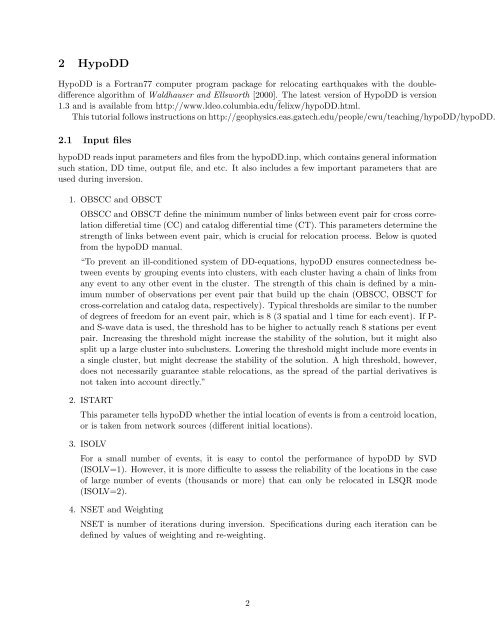Double Difference Earthquake Location(hypoDD) - Geophysics at ...
Double Difference Earthquake Location(hypoDD) - Geophysics at ...
Double Difference Earthquake Location(hypoDD) - Geophysics at ...
You also want an ePaper? Increase the reach of your titles
YUMPU automatically turns print PDFs into web optimized ePapers that Google loves.
2 HypoDD<br />
HypoDD is a Fortran77 computer program package for reloc<strong>at</strong>ing earthquakes with the doubledifference<br />
algorithm of Waldhauser and Ellsworth [2000]. The l<strong>at</strong>est version of HypoDD is version<br />
1.3 and is available from http://www.ldeo.columbia.edu/˜felixw/<strong>hypoDD</strong>.html.<br />
This tutorial follows instructions on http://geophysics.eas.g<strong>at</strong>ech.edu/people/cwu/teaching/<strong>hypoDD</strong>/<strong>hypoDD</strong>.<br />
2.1 Input files<br />
<strong>hypoDD</strong> reads input parameters and files from the <strong>hypoDD</strong>.inp, which contains general inform<strong>at</strong>ion<br />
such st<strong>at</strong>ion, DD time, output file, and etc. It also includes a few important parameters th<strong>at</strong> are<br />
used during inversion.<br />
1. OBSCC and OBSCT<br />
OBSCC and OBSCT define the minimum number of links between event pair for cross correl<strong>at</strong>ion<br />
differetial time (CC) and c<strong>at</strong>alog differential time (CT). This parameters determine the<br />
strength of links between event pair, which is crucial for reloc<strong>at</strong>ion process. Below is quoted<br />
from the <strong>hypoDD</strong> manual.<br />
“To prevent an ill-conditioned system of DD-equ<strong>at</strong>ions, <strong>hypoDD</strong> ensures connectedness between<br />
events by grouping events into clusters, with each cluster having a chain of links from<br />
any event to any other event in the cluster. The strength of this chain is defined by a minimum<br />
number of observ<strong>at</strong>ions per event pair th<strong>at</strong> build up the chain (OBSCC, OBSCT for<br />
cross-correl<strong>at</strong>ion and c<strong>at</strong>alog d<strong>at</strong>a, respectively). Typical thresholds are similar to the number<br />
of degrees of freedom for an event pair, which is 8 (3 sp<strong>at</strong>ial and 1 time for each event). If P-<br />
and S-wave d<strong>at</strong>a is used, the threshold has to be higher to actually reach 8 st<strong>at</strong>ions per event<br />
pair. Increasing the threshold might increase the stability of the solution, but it might also<br />
split up a large cluster into subclusters. Lowering the threshold might include more events in<br />
a single cluster, but might decrease the stability of the solution. A high threshold, however,<br />
does not necessarily guarantee stable reloc<strong>at</strong>ions, as the spread of the partial deriv<strong>at</strong>ives is<br />
not taken into account directly.”<br />
2. ISTART<br />
This parameter tells <strong>hypoDD</strong> whether the intial loc<strong>at</strong>ion of events is from a centroid loc<strong>at</strong>ion,<br />
or is taken from network sources (different initial loc<strong>at</strong>ions).<br />
3. ISOLV<br />
For a small number of events, it is easy to contol the performance of <strong>hypoDD</strong> by SVD<br />
(ISOLV=1). However, it is more difficulte to assess the reliability of the loc<strong>at</strong>ions in the case<br />
of large number of events (thousands or more) th<strong>at</strong> can only be reloc<strong>at</strong>ed in LSQR mode<br />
(ISOLV=2).<br />
4. NSET and Weighting<br />
NSET is number of iter<strong>at</strong>ions during inversion. Specific<strong>at</strong>ions during each iter<strong>at</strong>ion can be<br />
defined by values of weighting and re-weighting.<br />
2









